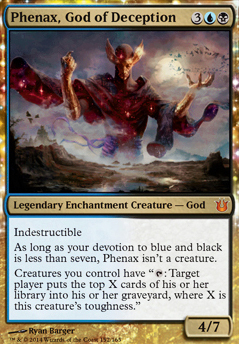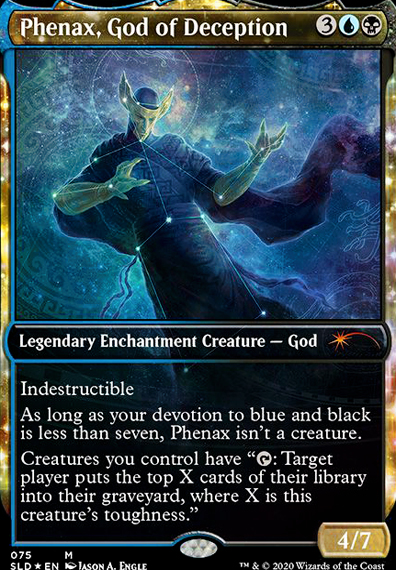The following ten parameters have been used to determine the strength of the deck. For each, a score of 5 (very good), 4 (good), 3 (mediocre), 2 (bad) or 1 (very bad) has been allocated; when totalized this score represents the power rating of the deck (maximum score is 50 points).
- Mana: indicates the availability of mana sources within the deck.
- Ramp: indicates the speed at which mana sources within the deck can be made available.
- Card Advantage: indicates availability of filter- and draw resources represented within the deck.
- Overall speed: indicates the deck’s potential for pace, based on resource availability and mana curve.
- Combo: indicates the measure of combo-orientation of the deck.
- Army: indicates the deck’s creature-army strength.
- Commander: indicates how much the deck is commander-oriented/dependent (less dependency is better).
- Interaction: indicates how much this deck can mess with opponents’ board states and turn-phases.
- Resilience: indicates whether the deck can prevent and take punches.
- Spellpower: indicates the availability and strength of high-impact spells.
Mana: 3
Dimir colors offer very little in terms of mana-resource options (especially cheap-to-cast ones), so for the most part this deck relies on artifacts for its energy needs. Additional mana can be provided by seven artifact rocks, an instant (black) mana spell and two artifacts that help at cheapening casts.
Ramp: 1
Not sure if this should be considered ramping, but an artifact that can steal lands from opposing graveyards has been included, which works very well in a mill deck!
Card Advantage: 5
No deck featuring blue is complete without copious amounts of card-advantage resources to make use of, so this deck is no different! In all it features sixteen cards that support this particular area. Eight of these are direct draw resources. Second strongest category is comprised of theft cards (five options). The remainder are tutors (two cards) and a repeatable wheel. Let’s face it though, the deck’s real card-advantage resources are its mill-cards, that deprive everyone else of their libraries.
Overall speed: 3
Compared to the average EDH deck, this particular one is considered of medium speed. Its mana resources are mediocre, its card advantage resources are relatively good and it’s average CMC isn’t very high. In order to cast from an early stage, it is really quite dependent on its rocks and cost-reduction enablers. However, when combined with the deck’s excellent CA-options and a low average CMC, it can hit the ground running and expand fast.
Combo: 2
There’s a few ways in which this deck is able to create infinite mill cycles, by damaging opponents per mill-cycle and having the damage itself be a trigger for a new mill-cycle. Other ways to win includes stealing opponents’ stuff and overpowering them with that OR use ways to have opponents mill their entire library in a single move.
Army: 3
Just about all of the twenty-six creatures in this deck, have been added not so much with the thought of strengthening the deck’s combat abilities, but more with the thought in mind that either they enable (more) milling OR they somehow can provide me with benefits caused by milling. About half the deck’s creatures has been chosen for this army because of (in part) their relatively high toughness scores (compared to their power scores).
Commander: 5
Though Phenax is a fantastic mill-enabler, the deck features a lot of very strong mill potential alongside. Thus having him out feels more like an added bonus to an already strong ensemble, instead of a true necessity.
Interaction: 5
If screwing with peoples’ libraries is not considered interaction, I wouldn’t know what is. Twenty-four cards allow for direct milling, while another seven creatures combined with the commander provide strong additional milling opportunities. Aside from milling, the deck has some decent stealing options, as well as some bounce/countering options.
Resilience: 1
In terms of protection, recursion and recovery, this deck scores very little points in its current configuration. It’s focused on offense much more than it is on defense.
Spellpower: 4
When it comes to pure, power-castings, this deck really has a nice number of doozies ready to rock! Ten very strong mill-spells with tremendous impact potential and a number of other very powerful draw and drain enablers.
Total power score: 32
Though the power-score for this deck is listed as relatively average, the easiness with which it influences play for all decks it faces simultaneously makes it more of a high-ender. Its resourcing is good, its speed is average but once it gets momentum it’s going to be very hard to stop by almost any conceivable deck (because practically none can function without too much of their libraries going missing).



